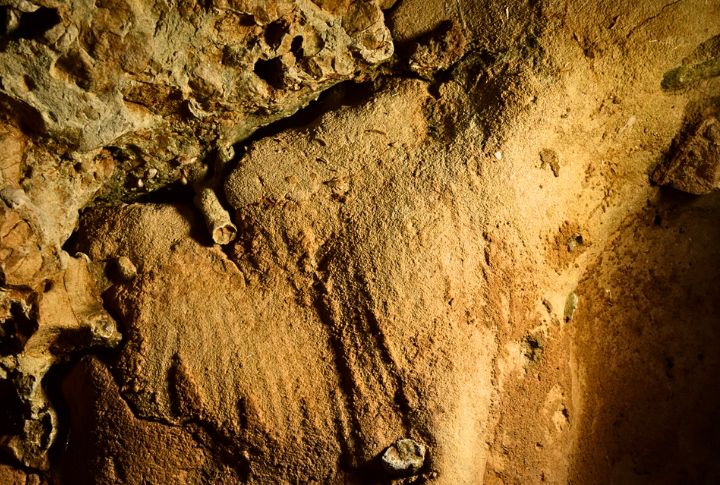
A cave sealed for 57,000 years is the kind of find archaeologists dream about. Opening it revealed objects untouched by human hands, each one offering a rare glimpse into a world shaped by Neanderthals alone. Curious what waited in that darkness for tens of millennia? Let’s uncover it piece by piece.
Mollusk Shell Bead
This small bead comes from a seashell that was deliberately drilled so it could be worn on a string. Because the cave is far inland, the shell must have been carried there on purpose. Finds like this suggest Neanderthals decorated themselves with simple jewelry, showing they cared about appearance and personal identity.
Dot Arrangements In Geometric Clusters
Rows of punctures carved into rock fragments show a steady, controlled hand behind each mark. The impressions match the pressure of a pointed tool, most likely bone or flint, used with intention. Their orderly clusters rule out chance and suggest counting, mapping, or ritual. This kind of structure also predates known human systems of meaning.
Finger Flutings On The Primary Cave Wall
These lines in the soft cave wall were made by dragging fingers across the clay. The patterns are intentional rather than accidental, and they match the size and reach of Neanderthal hands. Researchers interpret the patterns as early creative behavior, suggesting Neanderthals felt drawn to marking their spaces.
Bifacial Hand Axe
This tool was worked on both sides until it had a strong cutting edge. The way the stone flakes were removed points to a careful, organized method rather than guesswork. Therefore, Neanderthals clearly relied on thoughtful techniques long before Homo sapiens lived nearby.
Mousterian Flint Scraper

Found near sediment linked to Neanderthal activity, the scraper carries a polished working edge built through repeated retouch. It likely served tasks such as hide processing or cleaning bone. Scraper precision in its form points to practiced skill, proof that effective toolmaking was well established before modern humans arrived.
Charred Bison Femur With Cut Marks
Near an ancient ash bed, a burned bison bone shows a series of clean, parallel cuts made by a sharp flint edge. These marks create a clear pattern linked to purposeful butchery. The use of fire and the orderly slicing also point to a group working together on a meal.
Horse Jawbone Incised For Tool Use
A jawbone recovered near the hearth carries wear formed only through steady, repeated handling. Its edges hold shallow grooves where stone flakes were shaped and refined. Using an animal bone as a retoucher reflects practical reuse and a clear understanding of how different materials worked together.
Pigment-Holding Depressions
Red and black mineral traces sit inside shallow limestone cups shaped long ago. When mixed with fat or water, the pigments formed a workable medium for marking stone or skin. The care behind this setup points to preparation and an early interest in visual presentation within the group that used the cave.
Faint Animal Outline Engraving
Light from a handheld lamp revealed a faint outline of a large mammal etched into the limestone. Its steady proportions point to direct observation rather than chance marks. This early form of representational art predates nearby Homo sapiens activity, showing that the cave’s Neanderthal occupants also depicted the world around them.
Hollowed Quartz Lamp Base
A quartz block with a hollowed center lay beside a patch of soot inside the cave. Fat traces still cling to the cavity, marking it as a small lamp fueled by rendered fat. The representational artifact predates nearby Homo sapiens traces and reveals that Neanderthals also created visual records of their world.

